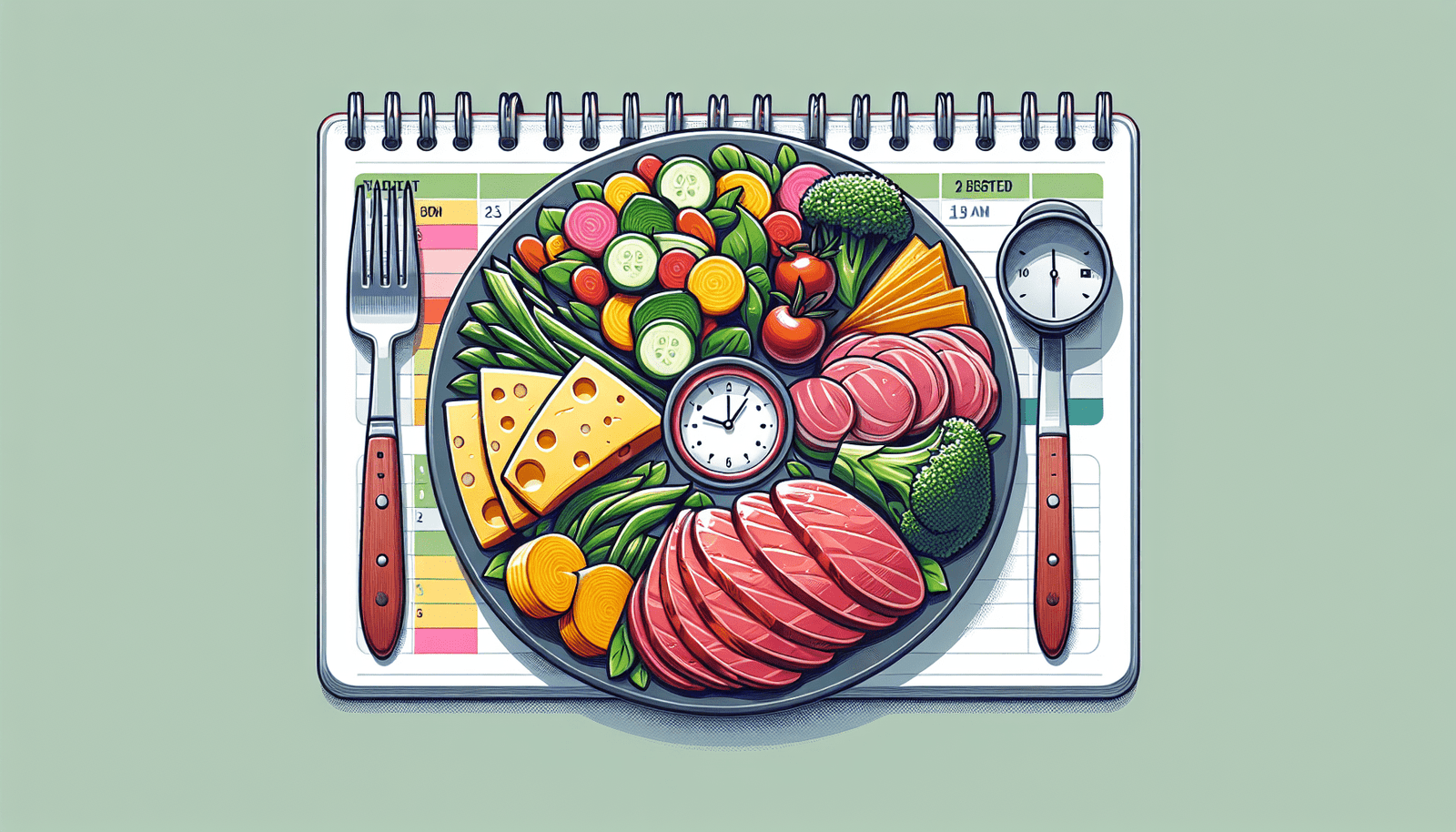Are you constantly on the go and find it challenging to stick to your keto diet during busy weekdays? Look no further! In this article, you will discover practical tips and strategies for creating a keto meal plan tailored to fit your hectic schedule. Whether you’re a working professional, a busy parent, or juggling multiple responsibilities, this guide will help you enjoy the benefits of a keto lifestyle effortlessly. Say goodbye to stress and hello to delicious, healthy meals that fuel your body and keep you on track!
Understand Keto Diet Basics
What is a Keto diet?
A Keto diet, short for ketogenic diet, is a low-carb, high-fat diet that puts your body into a metabolic state called ketosis. In ketosis, your body becomes extremely efficient at burning fat for energy instead of relying on carbohydrates. The main principle of a Keto diet is to drastically reduce your carbohydrate intake and increase your fat intake, while maintaining a moderate protein intake.
How does it work?
When you limit your carbohydrate intake, your body begins to break down stored fat into molecules called ketones. These ketones are then used as fuel by your body, including your brain, as an alternative source of energy instead of glucose derived from carbohydrates. By entering into a state of ketosis, your body becomes a fat-burning machine, leading to weight loss and various other health benefits.
Benefits of a Keto diet
The Keto diet has gained popularity due to its numerous health benefits. Some of the key benefits include weight loss, increased energy levels, improved mental clarity and focus, reduced inflammation, lower blood sugar levels, better insulin sensitivity, and improved cardiovascular health. Additionally, a Keto diet may also help manage certain medical conditions, such as epilepsy, PCOS, and type 2 diabetes.
Considerations and precautions
While the Keto diet can be highly effective for many individuals, it’s important to consider certain factors before starting this diet. It is always recommended to consult with a healthcare professional before making significant dietary changes, especially if you have any underlying health conditions. Additionally, it’s important to ensure you are getting a variety of nutrient-dense foods to meet your nutritional needs, as the Keto diet restricts certain food groups, such as fruits and grains. It’s crucial to stay hydrated, monitor your electrolyte levels, and listen to your body’s needs throughout your Keto journey.
Assess Your Daily Nutritional Goals
Determine your caloric needs
To create a personalized Keto meal plan, it’s important to determine your daily caloric needs. This can be calculated by considering factors such as your age, gender, weight, height, activity level, and weight goals. Several online calculators and apps are available to help you estimate your daily calorie requirements accurately.
Calculate macronutrient ratios for a Keto diet
In addition to calories, the Keto diet focuses on macronutrient ratios, which are the proportions of fats, proteins, and carbohydrates in your diet. Generally, a standard Keto diet aims for approximately 75% of calories from fat, 20% from protein, and 5% from carbohydrates. However, these ratios can be adjusted based on individual preferences and goals.
Choose the right portion sizes
Portion control is essential to ensure you are consuming the appropriate amount of macronutrients and maintaining ketosis. Measuring food portions using a food scale or using visual cues like hand sizes can help you achieve the right balance. A nutritionist or registered dietitian can provide guidance on portion sizes if needed.
Include essential vitamins and minerals
While the Keto diet primarily focuses on macronutrients, it’s important to also consider the intake of essential vitamins and minerals. Incorporating a variety of low-carb vegetables, such as leafy greens, broccoli, and cauliflower, can help provide essential nutrients. Additionally, supplementation or a well-rounded multivitamin can help fill in any nutritional gaps in your diet.

Plan Your Weekly Meals
Make an inventory of available ingredients
Before starting your Keto meal planning, take an inventory of ingredients you already have in your pantry and refrigerator. This will help you utilize what you already have and minimize waste. Knowing what you have on hand can also inspire creative meal ideas.
Research and select Keto-friendly recipes
There are numerous resources available online, including websites, blogs, and social media platforms, where you can find a wide variety of Keto-friendly recipes. Look for recipes that fit your dietary preferences, skill level, and time constraints. Consider bookmarking or saving recipes for future reference.
Create a meal schedule for the week
Once you have selected your recipes, create a meal schedule for the week. Determine which recipes you will prepare for breakfast, lunch, dinner, and snacks. Take into consideration any days when you may have less time to cook and plan for simpler meals or leftovers on those days.
Consider meal prep and cooking times
To make your weekdays less hectic, consider meal prepping certain components of your meals in advance. This can include washing and chopping vegetables, marinating meats, or pre-cooking certain recipe elements. Assess the cooking times of your chosen recipes to ensure they fit within your schedule.
Stock Up on Keto Pantry Staples
Healthy fats
As fats are a major component of the Keto diet, it’s important to have a variety of healthy fat sources on hand. These can include olive oil, coconut oil, avocado oil, grass-fed butter, ghee, and fatty cuts of meat. Incorporating a mix of saturated fats and monounsaturated fats will help provide essential nutrients and promote satiety.
Protein sources
Including adequate protein in your Keto meal plan is essential for maintaining muscle mass and supporting bodily functions. Stock up on protein sources such as eggs, chicken, turkey, beef, salmon, and tofu. Consider choosing high-quality, organic, and grass-fed options when possible.
Low-carb vegetables
Vegetables will provide essential vitamins and minerals while keeping your carbohydrate intake in check. Choose low-carb options such as leafy greens, cauliflower, zucchini, mushrooms, and bell peppers. Frozen vegetables can be a convenient option to have on hand when fresh produce is not available.
Dairy and dairy alternatives
Dairy products can be included in moderation on a Keto diet, but it’s important to choose full-fat options and be mindful of lactose content. Stock up on items like heavy cream, full-fat cheese, and Greek yogurt. If you prefer dairy alternatives, consider unsweetened almond milk, coconut milk, or oat milk.
Nuts and seeds
Nuts and seeds make for convenient and nutritious Keto-friendly snacks. Almonds, walnuts, macadamia nuts, chia seeds, and flaxseeds are excellent choices. Be cautious with portion sizes, as these foods are calorie-dense.
Low-carb sweeteners and spices
To add flavor to your meals and satisfy your sweet tooth, opt for low-carb sweeteners like stevia or erythritol. Stock up on a variety of herbs, spices, and seasonings to enhance the taste of your dishes without adding extra carbohydrates.

Prepare a Grocery List
Review recipes and check supplies
Once you have selected your recipes and made note of the required ingredients, thoroughly review each recipe. Check your pantry, refrigerator, and freezer to see if you already have any of the necessary ingredients. Make note of any items that need to be replenished.
Prioritize fresh and whole foods
When creating your grocery list, prioritize fresh and whole foods. Choose a variety of colorful vegetables, high-quality meats, and fresh herbs. Opt for minimally processed options and avoid foods with added sugars or unhealthy additives.
Organize the list by sections
To make your grocery shopping experience more efficient, organize your list by sections. Group similar items together, such as produce, meat, dairy, pantry staples, and frozen foods. This will help you navigate the store quickly and ensure you don’t miss any essential ingredients.
Batch Cooking and Meal Prep
Choose recipes suitable for batch cooking
Batch cooking involves preparing larger quantities of food and dividing them into individual portions for future meals. Choose recipes that lend themselves well to batch cooking, such as casseroles, soups, stews, or roasted meats. This will save you time and effort during the week.
Pre-cook and portion meals
Once you have cooked your batch meals, portion them into individual containers or meal prep containers. This will make it easier to grab a meal during busy weekdays and prevent you from reaching for unhealthy convenience foods. Label each container with the date and contents for easy reference.
Advance prep vegetables and proteins
To streamline your weeknight cooking, pre-cut vegetables and marinate proteins in advance. Store them in airtight containers or resealable bags in the refrigerator. This will help reduce prep time and make cooking meals quicker and more manageable.
Stock up on convenient grab-and-go snacks
In addition to preparing main meals, it’s important to have convenient Keto-friendly snacks on hand. Pre-portion nuts, seeds, cheese, or sliced vegetables into snack-sized containers or bags. These grab-and-go snacks will keep you satiated between meals and prevent reaching for unhealthy options.
Use Time-Saving Kitchen Tools
Slow Cooker
A slow cooker is a fantastic tool for busy weekdays. You can prepare ingredients in the morning, set it to cook, and return to a delicious, ready-to-eat meal in the evening. Slow cookers are especially useful for recipes like soups, stews, and pulled meats.
Instant Pot
The Instant Pot is a versatile kitchen appliance that combines the functions of a pressure cooker, slow cooker, rice cooker, and more. It allows you to cook meals quickly and efficiently. Instant Pot recipes can range from soups and roasts to yogurt and even cheesecakes.
Food Processor
A food processor can be a time-saving tool for chopping vegetables, shredding cheese, or making homemade sauces and dips. It speeds up the food preparation process, especially when dealing with larger quantities.
Blender
A blender is essential for making smoothies, shakes, and creamy keto-friendly soups. It can also be used to blend sauces, dressings, and nut butters. Look for a blender with a powerful motor and durable blades.
Air Fryer
An air fryer is a healthier alternative to deep frying and can quickly cook or crisp various foods, including chicken wings, vegetables, and even desserts. It uses hot air circulation to achieve a crisp texture without the need for excessive oil.
Create a Weekly Meal Schedule
Plan breakfast, lunch, dinner, and snacks
Using the recipes and meal ideas you have selected, create a weekly meal schedule that includes breakfast, lunch, dinner, and snacks for each day. Be mindful of balancing your macronutrients and incorporating a variety of flavors and textures to keep your taste buds satisfied.
Alternate leftover utilization
To minimize waste and save time, incorporate leftover utilization into your weekly meal schedule. For example, if you cook a whole roasted chicken one night, plan to use the leftover chicken in salads, stir-fries, or wraps for subsequent meals.
Consider variety and flavor balance
To prevent boredom and ensure you enjoy your meals, prioritize variety and flavor balance. Incorporate different protein sources, vegetables, and cooking methods throughout the week. Experiment with herbs, spices, and sauces to add depth and excitement to your dishes.
Allow for flexibility and adjustments
Remember that your meal schedule is a flexible guide, not a rigid plan. Life can be unpredictable, and unexpected events or cravings may come up. Allow yourself the flexibility to make adjustments and swaps when needed, ensuring you’re still meeting your nutritional goals while accommodating changes.
Monitor and Track Progress
Keep a food diary
Keeping a food diary can be a helpful tool for tracking your Keto journey. Write down everything you eat and drink, including portion sizes and any additional notes, such as how you felt after certain meals. This can help you identify patterns, pinpoint food triggers, and monitor your progress.
Track macronutrient intake
To ensure you are staying within your desired macronutrient ratios, track your daily intake of fats, proteins, and carbohydrates. There are various apps and online calculators available that can assist you in tracking your macronutrients and providing a breakdown of your nutritional intake.
Monitor weight and body measurements
In addition to tracking your food intake, monitor your weight and body measurements regularly. While weight loss is a common goal on the Keto diet, it’s important to remember that other factors, such as improved energy levels and body composition changes, can also indicate progress.
Consider using Keto-specific apps or tools
There are several apps and online tools designed specifically for the Keto diet. These resources can help streamline your tracking, provide recipe ideas, and offer guidance on meal planning. Explore different options and find one that suits your preferences and needs.
Seek Support and Accountability
Join a Keto community or support group
Finding a community or support group of like-minded individuals who are also following a Keto diet can be incredibly beneficial. Join online forums, social media groups, or local meet-ups to connect with others who share similar interests and experiences. This support network can provide motivation, inspiration, and a platform to share meal plans and recipe ideas.
Share meal plans and recipe ideas
Engaging with others in the Keto community by sharing your meal plans and recipe ideas can foster a sense of accountability and camaraderie. Collaborating and exchanging tips and tricks can help keep you motivated, prevent boredom, and introduce new flavors into your Keto journey.
Find an accountability partner
Having someone to hold you accountable in your Keto journey can greatly increase your chances of success. Find a friend, family member, or colleague who is also interested in following a Keto diet, and commit to supporting and motivating each other. Share your progress, challenges, and achievements, and celebrate milestones together.
Stay motivated and celebrate milestones
As with any lifestyle change, staying motivated is crucial to your success. Set small achievable goals for yourself and celebrate milestones along the way. Treat yourself to a non-food reward when you achieve a specific weight loss or health milestone. Remember to be kind to yourself and enjoy the process of improving your health and well-being through the Keto diet.

